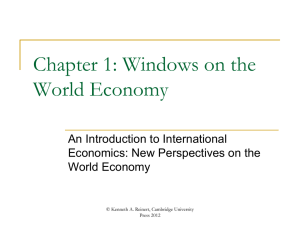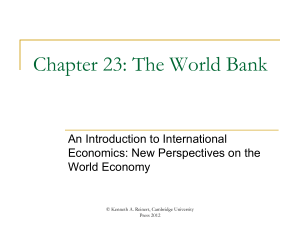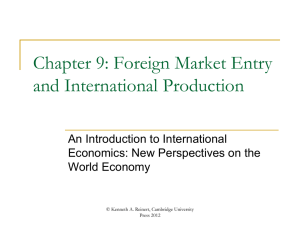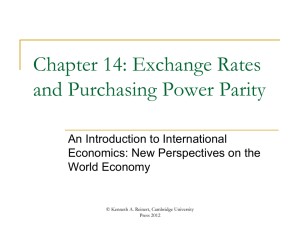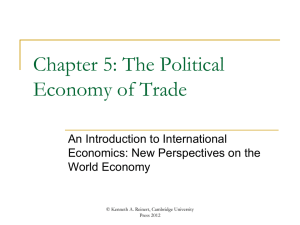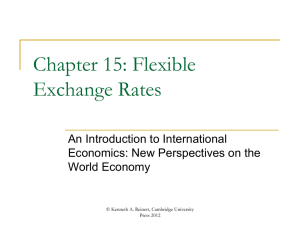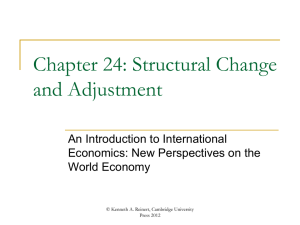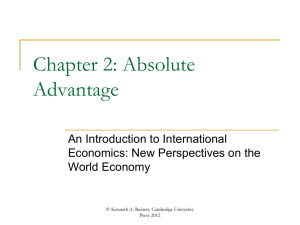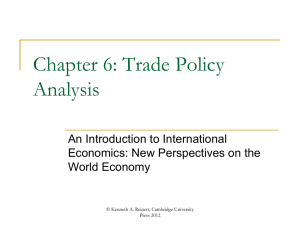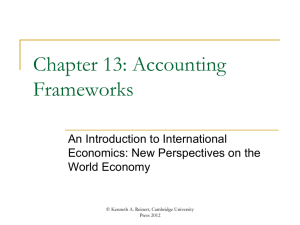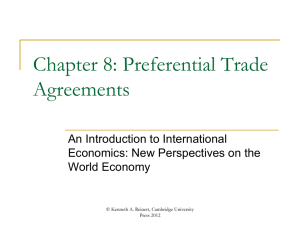Chapter 16: Fixed Exchange Rates. - An Introduction to International
advertisement
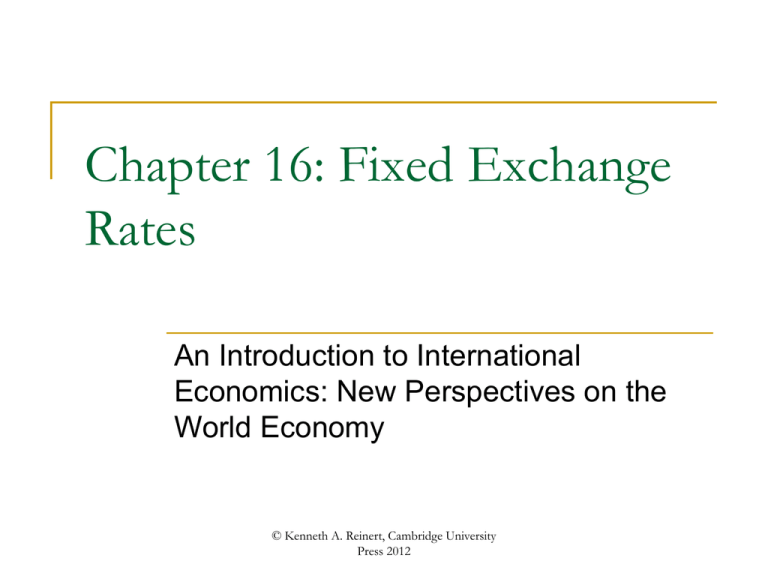
Chapter 16: Fixed Exchange Rates An Introduction to International Economics: New Perspectives on the World Economy © Kenneth A. Reinert, Cambridge University Press 2012 Analytical Elements Countries Currencies Financial assets © Kenneth A. Reinert, Cambridge University Press 2012 Alternative Exchange Rate Regimes Alternative exchange rage regimes are presented in Table 16.1 Flexible or (clean) float Managed (dirty float) Crawling bands Crawling pegs Fixed Currency board No separate legal tender One issue that has arisen is the durability of alternative exchange rate regimes This is considered in Table 16.2 © Kenneth A. Reinert, Cambridge University Press 2012 Table 16.1: Exchange Rate Arrangements, 2008 (Source: www.imf.org) Arrangement Description Number of Countries Flexible or (clean) float The exchange rate is market determined 40 Managed (dirty) float The exchange rate is primarily market determined, but the country’s monetary authority intervenes in the currency market to influence the movements of the exchange rate 44 Crawling bands The country’s monetary authority intervenes to maintain the exchange rate in a band around a central rate, and these bands are periodically adjusted 2 Crawling pegs The exchange rate is fixed in value to another currency or to a “basket” of other currencies, but adjusted periodically by small amounts 8 Fixed The exchange rate is fixed in value to another currency or to a “basket” of other currencies 71 Currency board The exchange rate is fixed in value to another currency, and domestic currency is fully backed by reserves of this foreign currency 13 No separate legal tender The legal tender of the country is a currency of another country 10 © Kenneth A. Reinert, Cambridge University Press 2012 Table 16.2: The Durability of Exchange Rate Regimes, 1975-2001 (years) Countries All regimes Pegs Intermediate Floats All countries 11.4 23.2 18.4 14.3 Advanced countries 19.4 46.0 26.8 88.0 Emerging markets 8.6 8.4 16.5 11.0 Developing 10.7 27.3 16.2 5.5 Source: Husain, Mody and Rogoff (2005) based on Reinhart and Rogoff (2004) © Kenneth A. Reinert, Cambridge University Press 2012 A Model of Fixed Exchange Rates In contrast to flexible or floating exchange rate regime, we will consider the polar opposite case of a fixed exchange rate regime Under a fixed exchange rate regime, when Mexican government raises (lowers) e and thereby decreases (increases) value of peso Mexico will be our home country United States will be our foreign country Called a devaluation (revaluation) of peso Contrasts with a market-driven, upward movement in e under a flexible exchange rate regime known as a(n) depreciation (appreciation) In practice, devaluations are more common than revaluations © Kenneth A. Reinert, Cambridge University Press 2012 Table 16.3: Mexican Balance of Payments, 2007 (billions of US dollars) Current Account Item Gross Net Major Balance Current Account 1. Goods exports 271.9 2. Goods imports -281.9 3. Goods trade balance -10.0 4. Service exports 17.6 5. Service imports -24.1 6. Goods and services trade balance -16.5 7. Net income -18.3 8. Net transfers 26.4 9. Current account balance © Kenneth A. Reinert, Cambridge University Press 2012 -8.4 Table 16.3: Mexican Balance of Payments, 2007 (billions of US dollars) Other Accounts Item Gross Net Major Balance Capital/Financial Account 10. Direct investment 18.8 11. Portfolio investment 11.3 12.Other investment -10.6 13. Capital/financial account balance 19.5 Official Reserve Transactions 14. Official reserves balance -10.3 Errors and Omissions 15. Errors and omissions -0.8 Overall Balance 16. Overall balance 0 © Kenneth A. Reinert, Cambridge University Press 2012 Table 16.4: Exchange Rate Terminology Revisited Case e Value of Peso Term Flexible e ↑ ↓ Depreciation Flexible e ↓ ↑ Appreciation Fixed e ↑ ↓ Devaluation Fixed e ↓ ↑ Revaluation © Kenneth A. Reinert, Cambridge University Press 2012 A Model of Fixed Exchange Rates Consider Figure 16.1 e0 represents the equilibrium exchange rate The supply of pesos is the negative of item 6, the goods and services trade balance This is where the supply of pesos given by the trade deficit equals the demand for pesos given by foreign savings It excludes net income (item 7) and net transfers (item 8). The demand for pesos relates to item 13, the capital/financial account balance The demand for pesos is therefore the non-official capital account balance. This excludes the actions of central banks (item 14) © Kenneth A. Reinert, Cambridge University Press 2012 Figure 16.1: The Peso Market © Kenneth A. Reinert, Cambridge University Press 2012 A Model of Fixed Exchange Rates Suppose that the Mexican government chooses to fix the exchange rate at e1 The value of the peso, 1/e1, is therefore above the equilibrium value of the peso, 1/e0 This situation is known as an overvaluation of the peso An overvaluation of the peso implies an excess supply of pesos or an excess demand for dollars The additional demand for pesos or supply of dollars can come from three sources (Table 16.3) positive net income (item 7) positive net transfers (item 8) positive net official reserve transactions (item 14) or drawing down foreign reserves © Kenneth A. Reinert, Cambridge University Press 2012 A Model of Fixed Exchange Rates Suppose that the Mexican government chooses to fix the exchange rate at e2 The value of the peso, 1/e2, is therefore below the equilibrium value of the peso, 1/e0 This situation is known as an undervaluation of the peso An undervaluation of the peso implies an excess demand for pesos or an excess supply of dollars The additional supply of pesos or demand for dollars can come from three sources (Table 16.3) negative net income (item 7) negative net transfers (item 8) negative net official reserve transactions (item 14) or building up foreign reserves © Kenneth A. Reinert, Cambridge University Press 2012 A Model of Fixed Exchange Rates Summarize Overvaluation Excess supply of pesos (demand for dollars) Central bank draws down foreign reserves Undervaluation Excess demand for pesos (supply of dollars) Central bank builds up foreign reserves © Kenneth A. Reinert, Cambridge University Press 2012 Interest Rates and Exchange Rates Another approach to maintaining a fixed exchange rate is to affect the equilibrium exchange rate We can analyze this by using the interest rate parity condition e e Suppose that the Mexican government successfully ensures that a fixed rate 1/e3 is an equilibrium rate rM rUS e e This implies that e3 = ee Therefore rm = rUS © Kenneth A. Reinert, Cambridge University Press 2012 Interest Rates and Exchange Rates By increasing or decreasing rm into equality with rUS, the Mexican government can move the SF graph in Figure 16.2 to the left or right until the equilibrium e and ee are identical If a home country wants to maintain an equilibrium fixed exchange rate, it must set its interest rate equal to that prevailing in the foreign country whose currency serves as a peg for the home country currency In practice, fixed exchange rates are maintained with combinations of net income, net transfers, official reserve transactions, and interest rates © Kenneth A. Reinert, Cambridge University Press 2012 Figure 16.2: An Equilibrium Fixed Exchange Rate © Kenneth A. Reinert, Cambridge University Press 2012 The Role of Credibility Expectations regarding the future exchange rate can be volatile and subject to a host of economic and political events If a fixed exchange rate comes under pressure from an incipient fall in demand (shift of SF to the left), this pressure must be alleviated via an increase in the homecountry interest rate There are two difficulties here Increases in interest rates are recessionary in that they suppress domestic investment Increases in interest rates can potentially play havoc in fragile domestic financial systems, particularly when capital can leave the country in the form of capital flight © Kenneth A. Reinert, Cambridge University Press 2012 The Role of Credibility Investors know what the potentially-negative impacts of an interest rate can be, and this information feeds back into expectations If investors begin the question the willingness and ability of the home country government to defend the fixed peg with interest rate increases, the expected rate of depreciation again becomes positive and the peg is no longer credible © Kenneth A. Reinert, Cambridge University Press 2012 The Impossible Trinity In the realm of international finance, countries would ideally like to pursue three desired objectives (the trinity) Monetary independence or the ability to conduct an independent monetary policy with an eye to stabilizing the domestic macroeconomic policy Exchange rate stability or the ability to avoid destabilizing volatility in the nominal exchange rate Capital mobility or the ability to take advantage of flows on the direct and portfolio capital accounts from foreign savings As it turns out, countries must sacrifice one of the above desired objectives in order to achieve the other two The impossible trinity is illustrated in Figure 16.3 © Kenneth A. Reinert, Cambridge University Press 2012 Figure 16.3: The Impossible Trinity © Kenneth A. Reinert, Cambridge University Press 2012 The Impossible Trinity Suppose a country wants to maintain both capital mobility and exchange rate stability Suppose a country wants to maintain both capital mobility and monetary independence The country must sacrifice exchange rate stability Suppose a country wants to maintain both monetary independence and exchange rate stability The country must sacrifice its independent monetary policy The country must sacrifice capital mobility Countries must give up one desired objective (monetary independence, exchange rate stability, or capital mobility) to attain the other two © Kenneth A. Reinert, Cambridge University Press 2012 Currency Boards Currency boards are a fixed exchange rate regime with two characteristics The fixed rate is presented as an inviolable commitment with legal backing in domestic legislation The central bank serving as the currency board fully backs up it base money (cash and commercial bank reserves) with foreign reserves stands ready to exchange the domestic currency and the foreign currency in either direction to any such request The most well-known example of a currency board was the Convertibility Plan of Argentina in place between 1991 and 2001 and ending in a crisis The usefulness of currency boards seems to be limited to certain small and very open economies © Kenneth A. Reinert, Cambridge University Press 2012 Monetary Policies Monetary polices in fixed exchange rate regimes can be understood with reference to Figure 16.4 The top diagram of this figure depicts equilibrium in the US money market and determines the interest rate on the dollar The bottom diagram depicts equilibrium in the Mexican money market and determines the interest rate on the peso The middle diagram depicts the peso market, being an equilibrium fixed exchange rate © Kenneth A. Reinert, Cambridge University Press 2012 Figure 16.4: Money Markets and Fixed Exchange Rates © Kenneth A. Reinert, Cambridge University Press 2012 Monetary Policies If income in Mexico (YM) increased If income in the United States (YUS) increased This would increase rM and the demand for pesos In order to prevent an appreciation of the peso, the Mexican central bank would need to increase the supply of pesos This would increase rUS and decrease the demand for pesos In order to prevent a depreciation of the peso, the Mexican central bank would need to decrease the supply of pesos If money supply (MSUS) in the United States increased This would decrease rUS and increase the demand for pesos In order to prevent an appreciation of the peso, the Mexican central bank would need to increase the supply of pesos © Kenneth A. Reinert, Cambridge University Press 2012 Monetary Policies In each of the above three cases, the Mexican government must stand ready to buy and sell pesos at to meet any excess supply or demand for pesos and, thereby, maintain the fixed exchange rate. Under a fixed exchange rate regime, a country cannot pursue monetary policy independently of the rest of the world such as with an eye to stabilizing its own macroeconomy Instead the monetary policy is committed to keeping the exchange rate fixed A country with a fixed exchange rate can control its interest rate or its exchange rate, but not both © Kenneth A. Reinert, Cambridge University Press 2012
